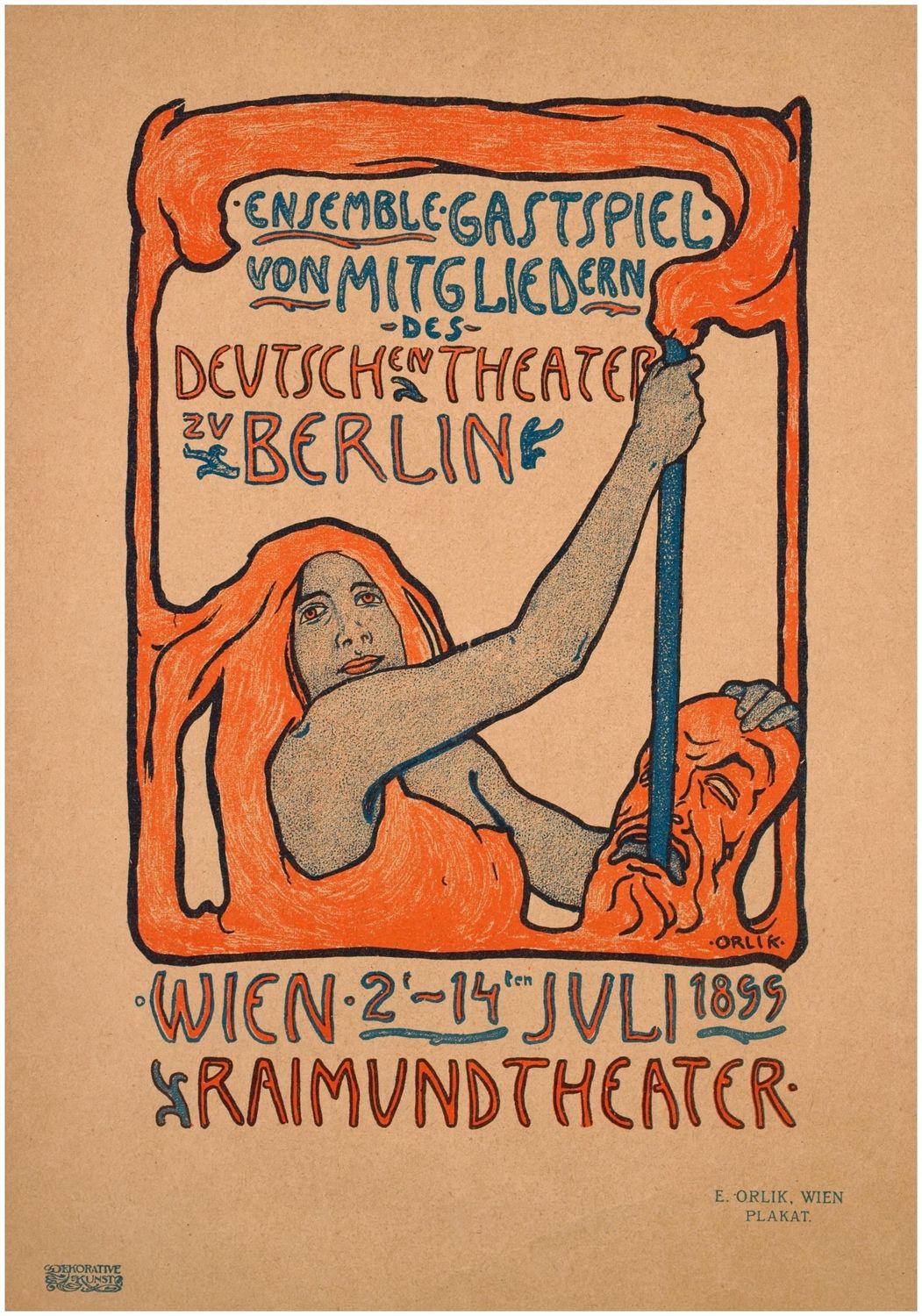Orlik, Emil (1870-1932), Performance by members of the Deutsches Theater zu Berlin, 1899
Emil Orlik(1870 Prague - 1932 Berlin), Ensemble guest performance by members of the Deutsches Theater zu Berlin , 1899. Color lithograph on wove paper, 20 cm x 13.3 cm (image), 29.5 cm x 21 cm (sheet size).
- somewhat darkened, small tears to the outer right margin, slight creases outside the image
- Ornamental Flow -
This graphic is a reduced version of the poster by Emil Orlik for the Deutsches Theater that appeared in the January 1900 issue of the Munich magazine 'Dekorative Kunst'. Still based in Prague, Orlik had become an internationally sought-after Jugendstil artist and was commissioned to design the poster for the Berlin theater's guest performance in Vienna. He combined lettering and figurative representation with flowing ornamentation. The flame of the torch in the theatrical mask is transformed by the flowing ornamental frame into the muse's hair and then into a mask from which the river seems to flow. The orange ornament is enlivened by the complementary color blue, which creates a pattern-like effect that is also reflected in the ornamental letters. Against this background, the poster is a programmatic image of Art Nouveau, which is why it found its way into the prestigious art magazine.
About the artist
Emil Orlik grew up in Prague and studied at Heinrich Knirr's painting school in Munich from 1889 to 1891 and then at the Munich Art Academy from 1891 to 1893. From 1894 to 1896, Orlik returned to Prague, where he did a year of military service and became friends with Reiner Maria Rilke, who inspired him to design books. In 1896 Orlik returned to Munich, where he developed an artistic friendship with Bernhard Pankok. The following year, Orlik opened a studio in Prague, which he ran until 1904. In 1898 he undertook a nearly year-long study trip to England, Scotland, Holland, Belgium and Paris. In 1904, Orlik became a teacher at the Vienna Museum of Decorative Arts. He had been a member of the Vienna Secession since 1899 and published in the Jugendstil magazine 'Ver Sacrum'. In 1905 he was appointed professor at the Berlin Museum of Decorative Arts, where he succeeded Otto Eckmann as head of the graphics class until Eckmann's death in 1932. George Grosz, Hanna Höch and Karl Hubbuch were among his students.
In 1900 Orlik made a year-long trip to Japan, which had a lasting influence on his art. In 1904 he published the portfolio "From Japan" and from 1905 to 1910 he illustrated the six-volume edition of the works of the English diplomat Lafcadio Hearn, who lived in Japan. In 1912 he made his second trip to Japan, which also took him to Egypt, Sudan, Ceylon, China, and Korea. His artistic impressions were reflected in the portfolios "Journey to Egypt" (1921) and "Journey to Japan" (1921). The late 1920s were also marked by numerous trips to America, France, Spain, Italy and Yugoslavia.
In addition to his artistic work as an interior designer, which included designs for costumes and stage sets for Max Reinhardt's Deutsches Theater, Orlik was primarily a graphic artist and sought-after portraitist. He painted portraits of Gerhard Hauptmann, Henrik Ibsen, Bernhard Pankok, Gustav Mahler, Max Klinger, Rainer Maria Rilke, Ernst Barlach, Lovis Corinth, Otto Dix, Käthe Kollwitz, Max Slevogt, Franz Werfel, Rudolf Steiner, Thomas Mann, Albert Einstein, Franz Marc and Alfred Döblin, among others. His virtuosity as a portraitist led Orlik to be hired as a portraitist for the Brest-Litovsk Peace Conference, which resulted in the portfolio "Caricatures from Brest-Litovsk" (1918).

